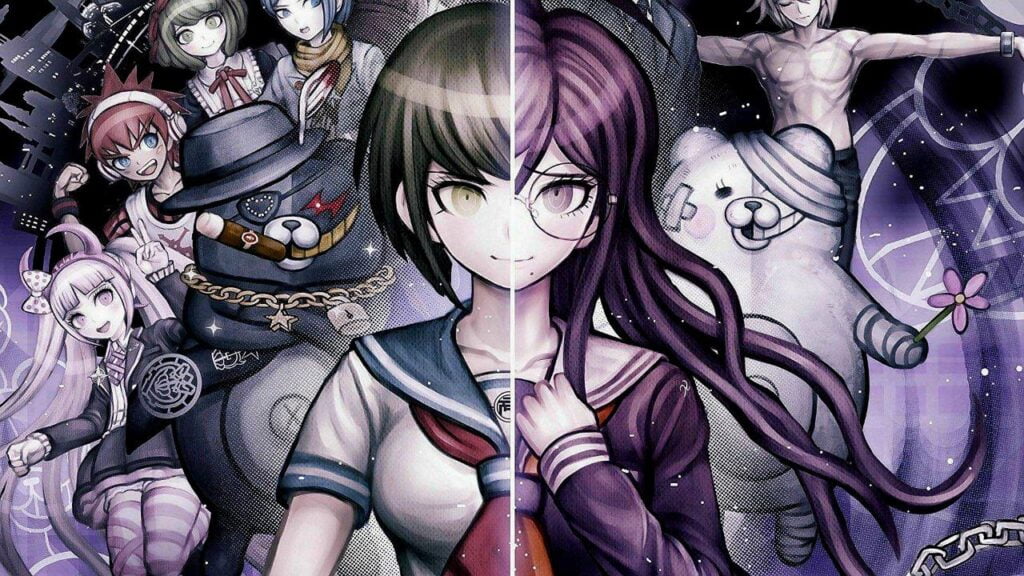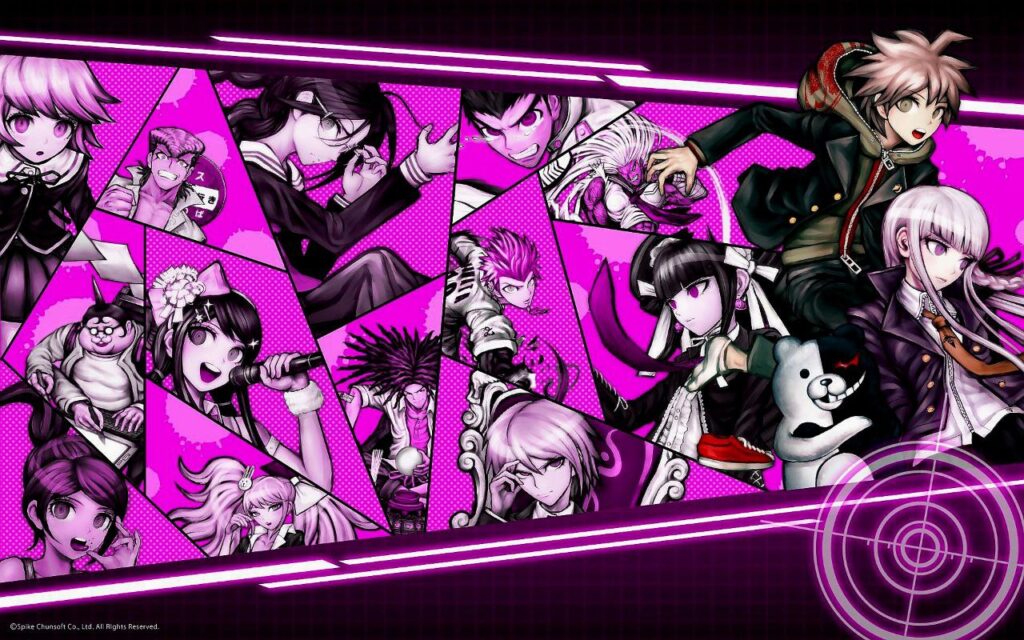
Introduction:
Danganronpa: The Animation, based on the popular video game series created by Spike Chunsoft, is a thrilling and intense anime that has captivated audiences worldwide. Released in 2013, this animated adaptation brings to life the sinister and mysterious world of Hope’s Peak Academy, where a group of exceptional students finds themselves trapped in a deadly game of despair. With its unique blend of psychological horror, murder mystery, and dark humor, Danganronpa: The Animation offers a gripping narrative that challenges the characters and viewers alike.
Plot Overview:
The story begins with Makoto Naegi, an average high school student, winning a lottery to enroll in Hope’s Peak Academy—an elite institution that only accepts the “Ultimate” students, individuals with extraordinary talents. However, upon entering the school, Naegi and his classmates discover that they are trapped inside, and the only way to escape is to commit the perfect murder.
Monokuma, a sadistic robotic bear, serves as the enigmatic mastermind behind this twisted game. Monokuma establishes a set of rules, pushing the students to the brink of despair. The tension rises as friendships crumble, and trust becomes a rare commodity among the students, who are now referred to as the “Ultimate Despair.”
The central theme of the anime revolves around the battle between hope and despair, as the characters face moral dilemmas, unexpected twists, and the constant fear of losing their lives in the deadly game orchestrated by Monokuma.
Character Development:
Danganronpa: The Animation excels in character development, offering a diverse cast with unique personalities, talents, and backstories. Each character is assigned a title based on their exceptional skills, ranging from the “Ultimate Swimmer” to the “Ultimate Programmer.” The clash of egos and personalities creates a volatile atmosphere within the group, adding complexity to the unfolding narrative.
Makoto Naegi, the protagonist, emerges as a symbol of hope amidst the chaos. His optimism and determination to uncover the truth become the driving force behind the narrative. As the story progresses, Naegi’s character undergoes significant growth, transforming from a seemingly ordinary student into a beacon of hope for his fellow classmates.
Antagonists such as Junko Enoshima, the “Ultimate Fashionista,” play a pivotal role in shaping the narrative. Enoshima’s cunning and manipulative nature contribute to the sense of dread, as she revels in the despair of others. The psychological cat-and-mouse game between the students and Enoshima adds layers of complexity to the plot, keeping viewers on the edge of their seats.
Murder Mysteries and Class Trials:
The core of Danganronpa: The Animation lies in its murder mystery elements and the subsequent Class Trials. As students fall victim to gruesome murders, the survivors must investigate the crime scenes, gather evidence, and engage in intense debates to unmask the killer. The Class Trials are a highlight of the series, featuring a unique mix of logic puzzles, mini-games, and psychological warfare.
The “Nonstop Debates” require players to identify contradictions in statements by shooting “truth bullets” to refute false claims. The “Bullet Time Battle” introduces rhythm-based gameplay, adding an extra layer of challenge. As the tension rises, the students face the daunting task of exposing the murderer while defending themselves from false accusations.
The anime masterfully adapts these elements, maintaining the suspense and intrigue that made the video game series a hit. The dynamic animation and engaging soundtrack enhance the intensity of the Class Trials, creating an immersive experience for viewers.

Themes of Hope and Despair:
Danganronpa: The Animation explores profound themes of hope and despair, questioning the limits of human resilience in the face of overwhelming odds. The characters grapple with their inner demons, confronting the darkest aspects of their personalities as they navigate the treacherous game orchestrated by Monokuma.
Hope’s Peak Academy, initially a symbol of excellence, becomes a prison of despair, forcing the characters to confront their deepest fears and insecurities. The concept of “Ultimate Despair,” embodied by Junko Enoshima, serves as a potent force that threatens to consume everything in its path. The juxtaposition of hope and despair creates a compelling narrative that challenges conventional storytelling norms.

Visual Style and Soundtrack:
Danganronpa: The Animation stands out for its distinctive visual style, characterized by vibrant colors, bold character designs, and dynamic camera angles. The animation effectively captures the tension and unease permeating the atmosphere of Hope’s Peak Academy. The use of contrasting colors, particularly red and black, adds a visual metaphor for the struggle between hope and despair.
The soundtrack, composed by Masafumi Takada, complements the series perfectly, enhancing the emotional impact of key moments. The music ranges from suspenseful and ominous tracks during investigations to energetic and intense tunes during Class Trials. The seamless integration of visuals and music contributes to the overall immersive experience of the anime.
Critical Reception and Legacy:
Danganronpa: The Animation received mixed reviews from critics and fans alike. While some praised its gripping narrative, unique premise, and memorable characters, others criticized its pacing and the adaptation’s inability to fully capture the depth of the video game experience. Despite the divided opinions, the anime garnered a dedicated fanbase that appreciates its unconventional approach to storytelling.
The success of Danganronpa: The Animation extended beyond the anime realm, inspiring manga adaptations, novels, and the creation of a successful video game franchise. The series’ impact on popular culture is evident in the numerous fan discussions, cosplay events, and the continued interest in the broader Danganronpa universe.

Conclusion:
Danganronpa: The Animation remains a standout in the anime landscape, offering a unique blend of psychological horror, murder mystery, and thought-provoking themes. Its compelling characters, intricate plot, and innovative gameplay elements have left a lasting impression on fans of the video game series and newcomers alike. The anime’s exploration of hope and despair, combined with its striking visual style and engaging soundtrack, creates an experience that lingers in the minds of viewers long after the final Class Trial concludes. Whether you’re a fan of the video games or a newcomer to the world of Hope’s Peak Academy, Danganronpa: The Animation promises an unforgettable journey into the depths of despair and the resilience of hope.
FAQ
- What is Danganronpa: The Animation?
- Danganronpa: The Animation is an anime adaptation of the popular video game series created by Spike Chunsoft. It follows the story of a group of exceptional students trapped in Hope’s Peak Academy, where they must engage in a deadly game orchestrated by the sadistic Monokuma.
- When was Danganronpa: The Animation released?
- The anime was first aired in 2013, bringing the dark and intense narrative of the Danganronpa series to life.
- What is the central theme of Danganronpa: The Animation?
- The central theme revolves around the battle between hope and despair. The characters find themselves in a high-stakes situation where they must confront their deepest fears and navigate through a series of murders and Class Trials to escape the clutches of despair.
- Who is the main character in Danganronpa: The Animation?
- Makoto Naegi is the protagonist of the series. He is an ordinary high school student who wins a lottery to enroll in Hope’s Peak Academy. Naegi becomes a symbol of hope as he navigates the deadly game and strives to uncover the truth behind the mysteries.
- What are Class Trials in Danganronpa: The Animation?
- Class Trials are pivotal moments in the anime where the surviving students must investigate murders, gather evidence, and engage in intense debates to unmask the killer. These trials involve various gameplay elements, including “Nonstop Debates” and “Bullet Time Battles.”
- Is Danganronpa: The Animation only for fans of the video games?
- While fans of the video games may appreciate the adaptation, Danganronpa: The Animation is designed to cater to both fans and newcomers. Its unique storytelling, character development, and themes of hope and despair make it accessible to a broader audience.
- How does the anime handle the psychological horror elements?
- Danganronpa: The Animation effectively incorporates psychological horror through its suspenseful plot, unexpected twists, and the constant threat of death. The eerie atmosphere and the characters’ internal struggles contribute to the overall sense of unease.
- What is the critical reception of Danganronpa: The Animation?
- The anime received mixed reviews, with praise for its gripping narrative and memorable characters, but some criticism for pacing issues. However, it has garnered a dedicated fanbase and contributed to the broader success of the Danganronpa franchise.
- Are there other media adaptations related to Danganronpa: The Animation?
- Yes, Danganronpa: The Animation has inspired manga adaptations, novels, and the creation of a successful video game series. The broader Danganronpa universe includes additional games and spin-offs that expand on the lore.
- Is there a recommended viewing order for Danganronpa: The Animation and related media?
- For newcomers, starting with Danganronpa: The Animation is recommended, followed by exploring the video games and other adaptations. The order of the games can be found online, and fans often discuss optimal viewing orders based on personal preferences.